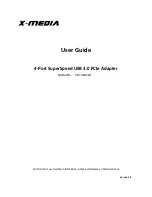
S e n d d o c u m e n t a t i o n c o m m e n t s t o m d s f e e d b a c k - d o c @ c i s c o . c o m
22-7
Cisco MDS 9000 Family CLI Configuration Guide
OL-16184-01, Cisco MDS SAN-OS Release 3.x
Chapter 22 Configuring Inter-VSAN Routing
Inter-VSAN Routing
Autonomous Fabric ID
The autonomous fabric ID (AFID) distinguishes segmented VSANS (that is, two VSANs that are
logically and physically separate but have the same VSAN number). Cisco MDS SAN-OS supports
AFIDs from 1 through 64. AFIDs are used in conjunction with auto mode to allow segmented VSANS
in the IVR VSAN topology database. You can configure up to 64 AFIDs.
The AFID can be configured individually for each switch and list of VSANs, or the default AFID can be
configured for each switch.
Note
Two VSANs with the same VSAN number but different AFIDs are counted as two VSANs out of the
total 128 VSANs allowed in the fabric.
IVR Service Groups
IVR service groups have the following characteristics:
•
You can configure as many as 16 service groups in a network.
•
When a new IVR-enabled switch is added to the network, you must update the service group to
include the new VSANs.
•
The same VSAN/AFID combination cannot be a member of more than one service group. CFS
merge fails if such a condition exists.
•
Total number of AFID/VSAN combinations in all the service groups combined cannot exceed 128.
The maximum number of AFID/VSAN combinations in a single service group is 128.
•
IVR control traffic is distributed in all the members of all the service groups. IVR data traffic
between two end devices belonging to a service group stays within that service group. For example,
two members pWWN 1 and pWWN 2 belonging to the same IVR zone but different service groups
cannot communicate.
•
During a CFS merge, service groups with same name would be merged, as long as there are no
conflicts with other service groups.
•
If the total number of service groups exceeds 16 during a CFS merge, the CFS merge fails.
•
CFS distributes service group configuration information to all the reachable SANs. If you do not
enable CFS distribution, you must ensure that the service group configuration is same at all the
IVR-enabled switches in all the VSANs.
•
IVR end devices belonging to an IVR service group are not exported to any AFID/VSAN outside of
its service group.
•
If at least one service group is defined and an IVR zone member that does not belong to a service
group, that IVR zone member is not able to communicate with any other device.
•
The default service group ID is zero (0).
Default Service Group
All AFID/VSAN combinations that are part of IVR VSAN topology but are not part of any user defined
service group are members of the default service group. The identifier of the default service group is 0.
By default, IVR communication is permitted between members of the default service group. You can
change the default policy to deny. The default policy is not part of ASCII configuration.
















































